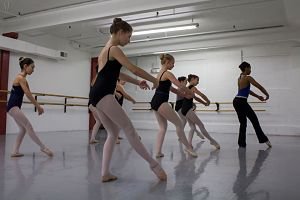
As choreographers and dance teachers we all have had those scheduled time frames where we need to set a piece in the course of one or two rehearsals on a Sunday when the studio is closed or over a vacation break. I have found that having a clear game-plan going into these types of choreography-settings can make the experience way less stressful and a wonderfully creative, productive and fun experience for you as well as your dancers! Here are some of my tips for the ONE DAY REHEARSAL MARATHON!
- Be prompt. Have your dancers be there a half hour before start time to warm-up, stretch and be ready to go!
- Have a strategy. What is your concept and how long is your piece? How long of a rehearsal do you have? Where will your breaks be? What can you feasibly accomplish in the allotted time? Do you have a clear vision of what this piece is about and how to articulately convey it to your dancers?
- Make an outline. Determine for yourself what sections will already be pre-choreographed. Where do you want to leave room for improvising? What is the basic structure? Do you have an idea of groupings, pathways, traffic? How you want to utilize the space? Draw floor maps and basic sketches of the groupings and entrances, exits, etc.
- Pre-cut music. Know the length of time your piece will be and edit all music prior to rehearsal so you don’t take up unnecessary time trying to figure out where a good place is in the music to cut and splice. This will keep the flow and consistency of the rehearsal going more effectively.
- What would you like to accomplish in that one rehearsal? This relates back to having a strategy. You may not be able to realistically get an entire piece done in one sitting…so think about what is most important to you to get set. Is it teaching the phrases? Is it improvising and playing with partnering? Is it laying out a basic structure of pathways and groupings? Is it starting from the top and working sequentially? Everyone’s process is different and you know how you and your dancers work best, so think about all this prior to walking into the studio.
- Who are your dancers? How many? Who is doing what? Think about the dancers who are in the piece. What are their strengths? Who will blend well together and complement one another other in certain small group sections? Who do you want to try certain partnering with? Who do you feel is ready to carry-off a solo or duet section? Leave yourself some wiggle room during the rehearsal to try different configurations with certain dancers.
- Who are your understudies/swings? If you have apprentices who are not in the piece but are required at the rehearsal to serve as understudies or swings, think about their strengths and which track suits them best. Understudying and swinging is no easy feat, so make sure those dancers are prepared at rehearsal with a notebook to learn their tracks.
- Have a Plan B. Sometimes, things just don’t work, even though in our head it seemed it would be perfect. That’s OK, it happens. My advice, don’t get frustrated and stay fixated on a section that just isn’t working that day. Return to it later with a fresh eye and have a Plan B for another section of the piece you can work on and set. No use trying to force something to work that needs some space to breathe. Revamp when you have the time to work it through and can come back and set it next time in half the time.
- Work out ideas for partnering and the mechanics ahead of time. Lay out your ideas for partnering. If you are trying some comprehensive lifts, make sure you understand the mechanics first of how to teach it to your students. While some of the best lifts, for me, have indeed come out of improvising, if you have something very detailed and specific in mind, make sure you are clear in your own mind so your dancers are as well.
- Give yourself room and a designated amount of time for play and trying new things. Always allot time for the unexpected. While it is important to have a clear idea of what you are working on, sometimes the most original movement, pathways, counterpoint, etc, come from that time in rehearsal that is not written in the book. Definitely not something to be overlooked just because of time constraint! So make sure you leave some time in there to experiment and see what comes out of pure movement and free play!
- HAVE A GREAT REHEARSAL!
- See you in the dance studio,
- Jessie

